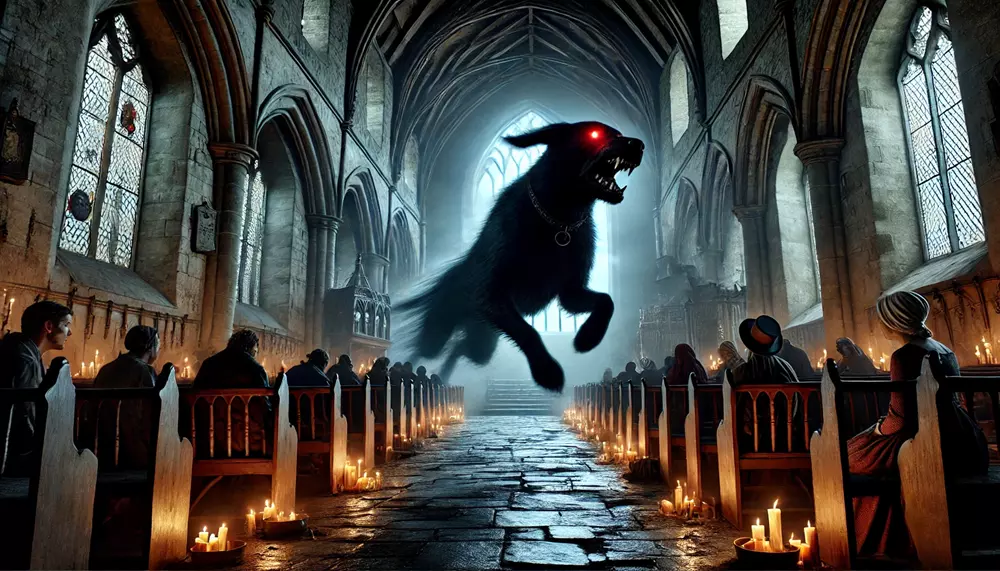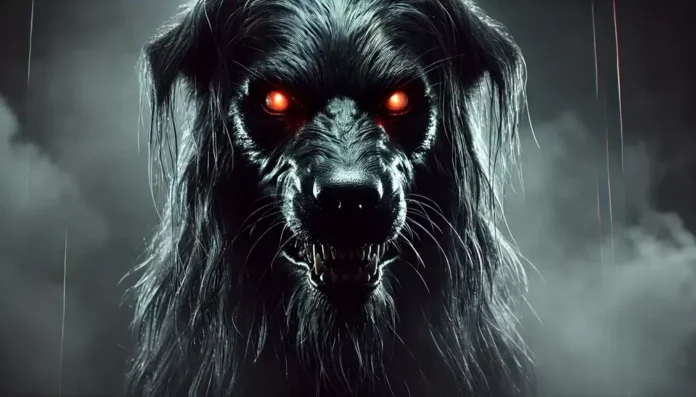Introduction
Black Shuck is a spectral black dog of English folklore, often described as an omen of death with fiery eyes and a foreboding presence. Said to roam the coastlines, moors, and graveyards of East Anglia, Black Shuck’s sightings are historically associated with terrible storms, eerie encounters, and tales of misfortune. As an embodiment of supernatural dread and a reminder of mortality, Black Shuck has inspired numerous ghost stories, local legends, and cultural references from medieval times to the present.
History and Origin
The earliest recorded mentions of Black Shuck appear in 16th-century England, primarily in Norfolk, Suffolk, and Cambridgeshire. However, tales of large, menacing black dogs may trace back to Anglo-Saxon beliefs. Known by names like “Old Shuck” and “Galleytrot,” Black Shuck became a symbol of death and a warning of disaster for those who encountered him.
In 1577, during a severe thunderstorm in Blythburgh, Suffolk, Black Shuck reportedly entered Holy Trinity Church. The historical record of this encounter states: “This black dog, or the devil in such a likeness… running all along down the body of the church with great swiftness and incredible haste, among the people, in a visible form and shape, passed between two persons as they were kneeling upon their knees, and wrung the necks of them both at one instant” (A Straunge and Terrible Wunder by Reverend Abraham Fleming, 1577). This account solidified Black Shuck as a spectral, malevolent entity.

Another early reference to Black Shuck is found in a letter by Sir Thomas Browne, a 17th-century English polymath, who described East Anglia as “a region that bred men full of dread and mystery, wherein oft appears a phantom hound, whose sight portends great sorrow.” The tales of Black Shuck persisted, symbolizing the dark, unpredictable forces of nature.
“The people of Suffolk speak often of a phantom hound that portends disaster; a beast of night whose eyes burn with an infernal light, known to all as Shuck.”(Sir Thomas Browne, letter circa 1660)
Name Meaning
The name “Black Shuck” likely derives from the Old English word scucca, meaning “demon” or “fiend.” The word reflects Black Shuck’s frightening reputation as a harbinger of death. Locals in East Anglia sometimes referred to him as “Old Shuck,” blending a term of endearment with an acknowledgment of his dark nature. Although the name varies regionally, all references to Black Shuck emphasize his role as a supernatural entity tied to death and mystery.
Background Story
The legend of Black Shuck is steeped in tales of fearsome encounters. Sightings describe a massive black dog with glowing red or green eyes, sometimes appearing as large as a calf or horse, roaming the English countryside and coastline. One of the most famous stories involves Black Shuck’s appearance at Blythburgh Church during a storm on August 4, 1577. According to accounts, Black Shuck burst into the church, wreaking havoc among the congregation, and left scorch marks on the church door—known locally as “the devil’s fingerprints”—which are still visible today.
The terrifying event was recounted by Abraham Fleming in A Straunge and Terrible Wunder, where he wrote: “Immediately a great crack of thunder happened, which rent the middle of the Church, and caused the people present to be abashed.” Following this storm, Black Shuck became synonymous with violent weather and misfortune. Tales like these cemented Black Shuck’s status as a terrifying omen, a spectral creature that appears in times of chaos or as a warning of death.
“This black dog, or the devil in such a likeness… running all along down the body of the church with great swiftness and incredible haste, among the people, in a visible form and shape, passed between two persons as they were kneeling upon their knees, and wrung the necks of them both at one instant.” (Abraham Fleming’s A Straunge and Terrible Wunder (1577)
In other stories, Black Shuck appears on lonely roads or graveyards, vanishing just as quickly as he appears. Often, those who see Black Shuck are met with a tragic fate shortly after the sighting. His image as a harbinger of death and misfortune continued to grow over centuries, and his presence served as a constant reminder of mortality and the unknown.
Cultural Impact
Black Shuck’s ominous presence has left a lasting mark on English folklore, particularly in East Anglia. His influence has extended beyond the region and is found in various aspects of literature, music, and art, serving as a cultural reference point for fear and mystery.
Local Landmarks and Folklore
Black Shuck’s appearances have become a part of East Anglian heritage. In towns like Blythburgh and Bungay, legends of Black Shuck are shared as local lore, with churches preserving scorch marks on doors as physical reminders of his tale. Tourists visiting Blythburgh often seek out the “devil’s fingerprints” on the church door, connecting them to the legend of Black Shuck.
Literature
Black Shuck has inspired several horror and fantasy novels, including The Hound of the Baskervilles by Sir Arthur Conan Doyle. Although Doyle’s ghostly hound is set in Dartmoor, the idea of a spectral black dog with fiery eyes shares similarities with Black Shuck, blending folklore with a gothic narrative. Black Shuck also appears in The Black Dog of Bungay by W.A. Dutt, which chronicles stories from East Anglian folklore.
Video Games
Black Shuck makes appearances in games set in mythological or folklore-rich settings. In Assassin’s Creed: Valhalla, a game based on Viking and English mythologies, Black Shuck is featured as a formidable creature that players must confront. This adaptation presents Black Shuck as a menacing beast, drawing on his fearsome reputation.
Comics and Graphic Novels
Black Shuck is depicted in the graphic novel Hellboy by Mike Mignola. In the story, Hellboy encounters a version of Black Shuck as part of his supernatural adventures, emphasizing Black Shuck’s place within dark, eerie narratives. This portrayal further solidifies Black Shuck’s role as a creature of mystery and fear.
Religion and Ritual
While Black Shuck is primarily associated with folklore, his legend intersects with religious beliefs in the sense that many of his reported appearances are in or around churches, particularly in times of violent storms or community crises. Black Shuck’s appearance in churches, especially during services, is viewed as an ominous warning or punishment for collective wrongdoing.
The tale of Black Shuck breaking into a church during a thunderstorm and killing two people echoes fears of divine retribution. His association with churches, combined with his demonic appearance, led some to interpret Black Shuck as a manifestation of the devil or a demon sent to punish the wicked. Even in modern times, some East Anglian communities regard Black Shuck as a reminder of humanity’s vulnerability to supernatural forces.
Scientific or Rational Explanations
Many folklorists suggest that the legend of Black Shuck originated as a way to explain sudden, tragic events. Black Shuck’s presence during thunderstorms or in ominous settings aligns with natural phenomena such as lightning and thunder, which can instill fear and create memorable experiences. His appearance in isolated areas like forests or coastlines can be explained as encounters with large animals or optical illusions created by shadows and fog.
The appearance of large, glowing eyes may have been attributed to reflective eyes of nocturnal animals, such as foxes or deer, which can appear otherworldly in low-light conditions. Some researchers, like historian W.A. Dutt, propose that Black Shuck’s tales might serve as moral warnings or reminders of mortality, particularly in rural communities where life was perilous and often dependent on nature’s whims.
In Modern Culture
The legend of Black Shuck continues to fascinate, appearing in a variety of contemporary contexts that keep the tale alive:
Music and Pop Culture
The rock band The Darkness brought Black Shuck to mainstream attention with their song “Black Shuck.” By integrating the story into a rock song, The Darkness popularized the legend for a new generation, highlighting its dark, energetic allure.
Tourism in East Anglia
Black Shuck-themed tours and local ghost walks are popular in East Anglia, where tourists can explore sites associated with the legend, such as the church in Blythburgh. The tours bring the folklore to life, making Black Shuck an important part of regional heritage and identity.
Supernatural TV Shows and Documentaries
Shows like Supernatural and documentaries exploring English folklore occasionally reference Black Shuck, associating him with other mysterious entities like the Grim or the Barghest, spectral dogs from northern English folklore. These representations help international audiences connect with the legend of Black Shuck.
Urban Legends and Horror Media
Black Shuck has been referenced in horror media, including podcasts and storytelling platforms dedicated to the supernatural. His image as an ominous dog has been used to convey dread and has inspired similar tales of ghostly dogs around the world.
Local Literature and Folklore Anthologies
Books like Haunted East Anglia include stories of Black Shuck, capturing the eerie details of his sightings and making the legend accessible to new readers. Such books celebrate regional folklore and provide a collection of Black Shuck tales, preserving his story for future generations.
Conclusion
Black Shuck remains a powerful symbol of mortality and the unknown in English folklore, embodying the darkness that lurks at the edges of human experience. His legend as a spectral black dog with fiery eyes has endured through centuries, inspiring fear, caution, and respect. As both an omen of death and a protector of rural landscapes, Black Shuck has become an inseparable part of English cultural heritage, haunting literature, music, and art. His tale reminds us that even in modern times, mysteries of the natural and supernatural persist, and legends of creatures like Black Shuck continue to captivate the human imagination.




